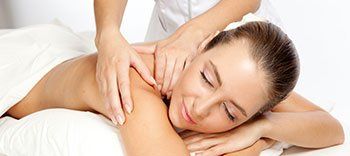We always recommend massage therapy as part of the healing process. Especially if there was a serious or traumatic injury involved, such as an injury at work or in an automobile.
Think of the last time you bumped your knee or had a muscle pull. What did you do? You rubbed it, right? Over the years, many cultures have intuitively developed a wide range of therapeutic techniques for a variety of conditions.
The benefits of massage therapy are now well documented. Not only does it reduce stress and make you feel good, it actually improves overall health and can be used to reduce pain and spasm in chronic conditions and speed healing of soft tissue sports injuries or traumatic events due to accidents at work or in the car.
The many different types of massage treatment protocols vary depending on the injuries and on the goals desired:
- Swedish massage. The most common massage; is a gentle form of massage that uses long strokes, kneading, and friction techniques on the more superficial layers of the muscles, combined with active and passive movements of the joints to help relax and energize you. Swedish is commonly part of any massage therapy.
- Deep massage. This massage technique uses slower, more-forceful strokes, often across the grain of the soft tissue, to target the deeper layers of muscle, tendons, and connective tissue, commonly to help with damage from injuries.
- Trigger point massage. Concentrated pressure to "trigger points" (painful irritated areas in muscles) to break cycles of spasm and pain and focuses on areas of tight muscle fibers that can form in your muscles after injuries or overuse. TP will decrease spasm and referred pain, re-educate muscle fibers, and increase healthy metabolic function in the involved areas.
- Sports massage. This is similar to Swedish massage, but it's geared toward people involved in sports activities to help prevent or treat injuries.
- Myofascial Therapy. Myofascial release is manipulative in nature and seeks to rebalance the body by releasing tension in the muscles and the fascia. It increases mobility, relieves muscle spasms, stretches fibrotic tissues, and breaks adhesions to promote distraction and gliding of joint facets.
Therapy for Women:
- Pregnancy and Postpartum Massage:
The benefits of Pregnancy Massage include relaxation, stress reduction, relief from muscle cramps, spasms, and myofascial pain, especially in the lower back, neck, hips, and legs, as well as reduced swelling and stress on joints. - Massage for mastectomy and other breast surgeries
Therapeutic massage can improve overall health and wellness in many different ways. We provide professional massage and chiropractic services for health, and well-being, and for injuries.

